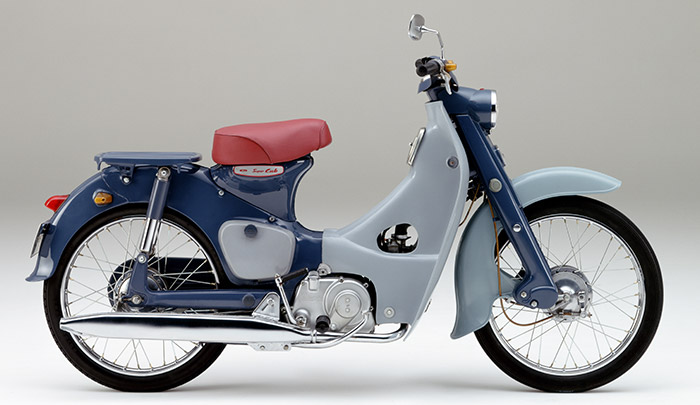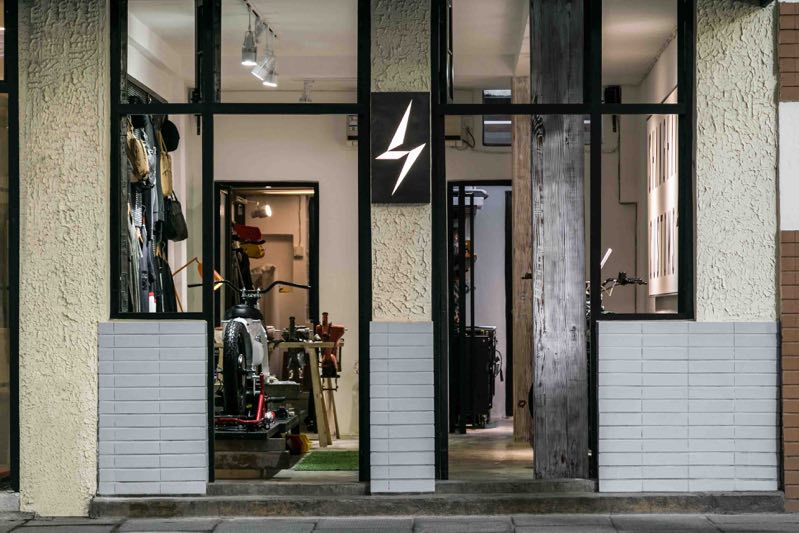
The Honda Cub is the best selling motor vehicle of all time, with over 100 million having been made in the years since 1958, when it was launched. Its origins are not in Japan, but in 1956 Europe when Honda co-founders Soichiro Honda (1906 – 1991) and Takeo Fujisawa (1910 – 1988) toured Germany and experienced the popularity of mopeds and other lightweight motorcycles.
Fujisawa was inspired, and wanted to produce a motorcycle for everyone: urban, rural or somewhere in between, living anywhere from a developed to an emerging economy. It had to be simple to survive in places without roads, advanced technology or access to reliable spare parts. It had to be quiet, reliable and easy to use. It also needed to have mass appeal, so that it could be produced on an enormous scale.
A scooter was considered but rejected: it was too complex for people in emerging economies, and, its wheels were too small for poorly maintained roads. Fujisawa specified ease of driving, by requiring that it could be driven with one hand while carrying a tray of soba noodles in the other. He is quoted as saying, “If you can design a small motorcycle, say 50 cc with a cover to hide the engine and hoses and wires inside, I can sell it. I don’t know how many soba noodle shops there are in Japan, but I bet you that every shop will want one for deliveries.”
Honda’s new vehicle was a 1958 Super Cub C100. It featured a low-floor backbone step-through pressed-steel frame. One important innovation, was their use of inexpensive but light weight plastic for the front fender and leg shields. This was the first motorcycle use of plastic. While the vehicle combined the characteristics of a scooter with the stability of a motorcycle. The 17-inch wheels, especially, gave the vehicle a stability not found in scooters. An automatic centrifugal clutch 3-speed transmission, and an air-cooled 4-stroke 49 cc (despite the model name) OHV engine, powered the vehicle. Top speed 65 km/h. Wheelbase 1 181 mm, Length 1 781 mm, Width 569 mm, Mass (wet) 65.0 kg.
The design was tested in advance of production, to eliminate any flaws. It would cost too much to fix problems after production started. It almost worked, except for an issue with the clutch, that required production and sales staff to visit each customer at home to fix each vehicle.
The early history of the Honda Cub will end here, with interested readers encouraged to either read the Wikipedia article or watch a more enjoyable but less extensive 8 minute video about it.
One challenge facing the world is reducing carbon emissions, and eliminating fossil fuels. This means transforming Honda Cubs into electric vehicles. So, even though Honda made an e-Cub prototype in 2019, they have never developed it into a production model. Why not? Is it because they are in too close a relationship with fossil fuel suppliers?

Shanghai Customs Ltd was founded by Alexander Style. It sells e-Cub kits throughout the world for US$ 2 800. There are three kits available for the C50, C70 and C90 models. The non-battery kit lacks more than just a battery. However, it claims to come with everything needed except a battery, charger, frame, front forks and front suspension. One step up is the full kit. The name is a misnomer, since it too is another partial kit, which is like the above kit but with a battery and charger. The full kit with frame and forks provides everything needed for an e-Cub build. Kits are designed for amateur installation, described as plug and play, with colour coded and numbered wiring. Assembly takes from about 15 hours of work, using only hand tools. The finished e-Cub is powered by a removable 1.3 kWh Panasonic battery that provides energy to a 1 000 W, rear hub motor, that can be boosted to 3 000 W for short periods. Top speed for the vehicle is still 65 km/h, with a range of 50 km. Included in the kit are new LED lights, and fully digital instrumentation.
Fully Charged YouTube channel presented a nine minute video about the company, and its conversion kits.
Phil Tucker commented 2021-02-25 on the YouTube video: “(Don’t get me wrong as I’m a massive “all electric” fan….) but I’m not necessarily convinced that someone who maybe bought an old hand me down cub off an older brother or sibling for say, fifty dollars to use to go to work on is then going to decide to spend 2500 dollars to go electric! Also I think some of those brand new Chinese electric bikes are actually cheaper than that?”
This brought several interesting replies including one from Siclmn Cyclerider: “I spent $6,000 on a Stromer electric bicycle.” However, several others commented on the need for improved brakes, that appear to come with the kit.
To put the e-Cub in perspective, it should probably be compared with a minimalist electric car, such as a Citroën Ami, measuring 2 410 mm in length, 1 390 mm (excluding mirrors) in width and 1 520 mm in height, with a total weight of 485 kg. It has a 6 kW electric motor operating at 48 V, and powered by a 5.5 kWh lithium-ion battery. It is registered as a light quadricycle for two, allowing a top speed of 45 km/h, and a range of 75 km. When it was first released, it came with a purchase price of $6 600, a leasing fee of $22 per month, or an on-demand rental for around $0.29 per minute.
One major difference between the two vehicles is that while the Ami is a purchase of a product, the e-Cub is buying parts for a project. This involves people with two totally different mindsets. The e-Cub will only appeal to people who have the desire, time and opportunity to customize their own vehicle. The Ami will only appeal to people who want to buy happiness.
Note: There will be no attempt to enter fruitless discussions about other best selling vehicles. Contenders will not even be named. The point of this weblog post is to examine a potential waste recycling challenge, that allows people to continue to use a perfectly good vehicle, despite its currently inappropriate power source, by replacing it with a suitable electric power train. Mopeds may not be for everyone, but this writer is convinced that in Inderøy they are part of a Rite of Spring where, much like the return of the swallows to Mission San Juan Capistrano, thousands of mopeds appear on the roads, allowing their 16-year old drivers to self-certify themselves as adults, and slowing traffic to 40 km/h. More mature readers, no longer subject to the excesses of teenage hormones, may prefer to see new opportunities that emerge from using a mobility scooter which, fortunately, are already electrified.
To this day, a Honda 50, probably a 1966 model, owned at the time by Victoria Ayerbe, is the only motorcycle I have ever driven, and only once. I have no intention of repeating this experience with either a fossil fuelled or electrified motorcycle. Indeed, I have no intention of converting a Honda Cub to an e-Cub. However, I would like to encourage people in Inderøy involved in the electrification of old scooterettes, as they were often called, possibly at Reodor, Inderøy’s bicycle repair shop. There could be other two-wheeled vehicle models that, because of local popularity, are more deserving to be adapted to electric power. Making kits for these could be an enjoyable community project. If readers have particular candidates for conversions, please tell other readers about them by making appropriate comments.


A comment from Peter:
Those small motorbikes were named “Honda 50”s in the S. London area.
And were popular ‘when I was a lad’ or teenager, They filled a gap in the markets between underpowered and cranky mopeds, and real motorbikes. Many a rider who tried out a Honda 50 found them underpowered and would hardly reach 30mph but the requirement was to use the accelerator (gas) and push motor revs up to the 6000-10000 zone then it could attain a better acceleration and more respectable top speed.
Lovely bikes, that were much more robust, reliable, and hard wearing than many others that we had like Triumphs, Ariels, and BSA’s etc.